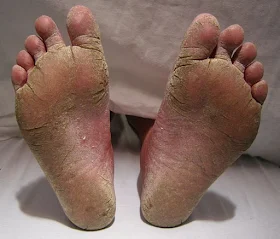Tinea Pedis- An Introduction:
Foot ringworm as one calls it or Tinea Pedis infects the hands along with the feet as a result of the fungi resident in the toe’s soles or Interdigtale clefts of the nails. It is popularly called an athlete’s foot. Many parts of Africa, Australia, and Asia were victims of the dermatophyte Trichophyton rubrum which was determined as the main reason for the infection.
Usually developing in-between the toes, athlete's foot also called Tinea Pedis is yet another type of fungal infection.
People may have feet that are sweaty due to the fact they prefer tight-fitting shoes. These people are more susceptible to this problem.
Athletes' foot is characterized by itchy, stinging rashes which cause both burning along with itching.
The disease is contagious and is certain to spread through contact with infected floors, towels or the clothing one wears.
The athlete's foot is closely related to other fungal infections such as ringworm and jock itch. It can be treated with over-the-counter antifungal medications, but the infection often recurs. Prescription medications also are available.
Symptoms:
Athlete's foot usually causes a scaly red rash. The rash typically begins in between the toes. Itching is often the worst right after you take off your shoes and socks.
Some types of this ailment feature blisters or ulcers. The moccasin variety of athlete's foot causes chronic dryness and scaling on the soles that extends up the side of the foot. It can be mistaken for eczema or dry skin.
The infection can affect one or both feet and can spread to your hand — especially if you scratch or pick at the infected parts of your feet.
The symptoms of this ailment are usually red and scaly. Rashes often start appearing between toes. Taking off your shoes and socks is usually the time when you experience the most itching.
In addition to this, ringworm along with jock itch is also a fungal infection.
Antifungal medications could be purchased across the counter for treating this infection, but more often than not the fungal infection tends to recur.
There are medications available on prescription too.
These aforesaid mentioned symptoms help a doctor too in his diagnosis of assessing the Athletes foot syndrome. He would locate the infected skin and scrape off a meager portion of it. The piece would be immersed in a Potassium Hydroxide container. The chemical mix would attack the normal cells and destroy them. The affected fungi cells would remain as such which is subject to examination with the aid of a microscope.
What is Vesicular Tinea Pedis
A combination of multiple fungi leads to this most commonly known Vesicular athlete's foot. The origin of this or the first symptoms is the infection in the toe web. In common parlance, it is called ' Jungle Rot'. It is generally associated with fire servicemen who engage in fighting fire under conditions that are more associated with heat.
Vesicular Athlete’s foot is largely due to T. Interdigtale. They increase in numbers due to their association with the Vesicles along with Pustules. These can be found on the mid- anterior plantar surface.
Treatment of Athlete's Foot:
It can be treated with home remedies or Allopathy.
Here is a list of different home remedies suggested to the ailment:
1. Treatment - - Counter (OTC)
Buy it in the form of powders, lotions, ointments, or sprays through OTC. Apply these to whichever area is infected for only a week to know the improvement. 2. Tea Tree Oil
It is abundant in antibacterial along with Antifungal properties and fungal infections caused by ringworm can be easily cured. For best results mix coconut oil with 25% to 50% of tea tree oil and the ailment would disappear in a few weeks
3. Hydrogen Peroxide:
It kills the fungus at surface levels.
For best results pour the mix onto the affected area.
4. Garlic
Garlic has certainly one of the strongest ingredients to cure this ailment. The process is to
- Take four pieces of Clive, crush them, and apply over the affected area
5. Alcohol:
If the fungi are found on the top of the skin there are two methods available. They are
- Mix the Hydrogen Peroxide with water in the ratio of 70: 30.
- Soak your affected parts of the feet in this mix for an approximate half-hour every day till it heals.
The second method is to carefully apply the peroxide to the infected area.
Found below are the medicines which can be applied on the infected areas.
- Miconazole (Micatin, Zeasorb powder),
- Econazole (Spectazole),
- Clotrimazole (Lotrimin),
- Terbinafine (Lamisil),
- Naftifine (Naftin),
- Butenafine (Mentax), ciclopirox (Loprox),
- Ketoconazole (Nizoral),
- Efinaconazole (Jublia),
- Luliconazole (Luzu),
- Sertaconazole (Ertaczo),
- Sulconazole (Exelderm),
- Tolnaftate (Tinactin).
What is B35.3?
ICD-10-CM Code for Tinea pedis B35.3
Infections and parasites are two types of ailments classified under ICD-10-CM codes by WHO. Tinea Pedis includes:
- Athlete's foot
- Dermatophytosis of foot
- Foot ringworm
- Epidermophyton,
- Microsporum and
- Trichophyton
- Tinea,
- Any type except those in B36.-
Conclusion:
As the condition is contagious, you shouldn't spread it. It is best to avoid scratching the affected area and clean your hands after the application of medicine. It is essential to contain the fungal infection and not let it develop into a bacterial one.

No comments:
Post a Comment